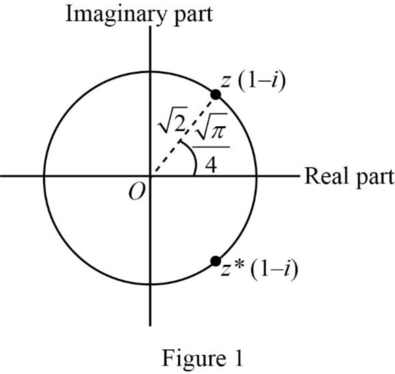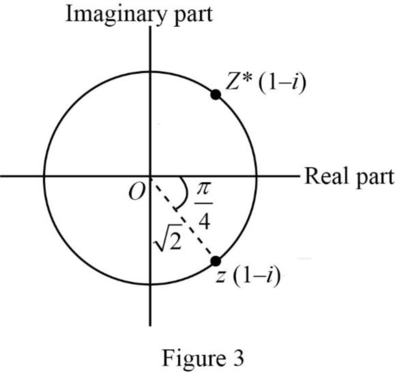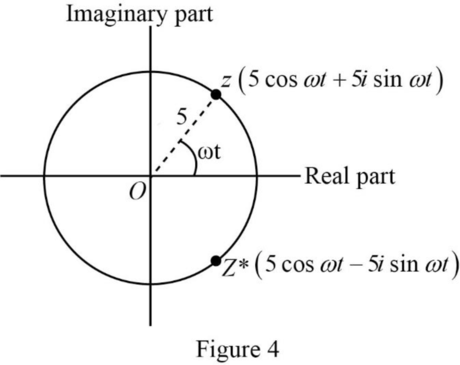
Concept explainers
(a)
The real and imaginary parts of the complex number, the modulus and phase of the complex number, the complex conjugate, and sketch
(a)
Answer to Problem 2.46P
The real part of complex number is
Explanation of Solution
Write the general form of complex number.
Here,
The given complex number is
Compare the above equation with equation (I).
Write the expression for modulus of the complex number.
Here,
Use equation (II) in the above equation.
Write the expression for phase angle.
Here,
Use equation (II) in the above equation.
Write the complex conjugate of the complex number
Here,
Write the other form of complex number
Here,
Figure 1 represents the sketch of

Conclusion:
Therefore, the real part of complex number is
(b)
The real and imaginary parts of the complex number, the modulus and phase of the complex number, the complex conjugate, and sketch
(b)
Answer to Problem 2.46P
The real part of complex number is
Explanation of Solution
Write the general form of complex number.
Here,
The given complex number is
Compare the above equation with equation (IV).
Write the expression for modulus of the complex number.
Here,
Use equation (V) in the above equation.
Write the expression for phase angle.
Here,
Use equation (V) in the above equation.
Write the complex conjugate of the complex number
Here,
Write the other form of complex number
Here,
Figure 2 represents the sketch of

Conclusion:
Therefore, the real part of complex number is
(c)
The real and imaginary parts of the complex number, the modulus and phase of the complex number, the complex conjugate, and sketch
(c)
Answer to Problem 2.46P
The real part of complex number is
Explanation of Solution
Write the general form of complex number.
Here,
The given complex number is
The above complex number can be written as
Rearrange the above equation.
Compare the above equation with equation (IV).
Write the expression for modulus of the complex number.
Here,
Use equation (VIII) in the above equation.
Write the expression for phase angle.
Here,
Use equation (VIII) in the above equation.
Write the complex conjugate of the complex number
Here,
Figure 3 represents the sketch of

Conclusion:
Therefore, the real part of complex number is
(d)
The real and imaginary parts of the complex number, the modulus and phase of the complex number, the complex conjugate, and sketch
(d)
Answer to Problem 2.46P
The real part of complex number is
Explanation of Solution
Write the general form of complex number.
Here,
The given complex number is
The above complex number can be written as
Compare the above equation with equation (X).
Write the expression for modulus of the complex number.
Here,
Use equation (XI) in the above equation.
Write the expression for phase angle.
Here,
Use equation (XI) in the above equation.
Write the complex conjugate of the complex number
Here,
Figure 4 represents the sketch of

Conclusion:
Therefore, the real part of complex number is
Want to see more full solutions like this?
Chapter 2 Solutions
Classical Mechanics
 College PhysicsPhysicsISBN:9781305952300Author:Raymond A. Serway, Chris VuillePublisher:Cengage Learning
College PhysicsPhysicsISBN:9781305952300Author:Raymond A. Serway, Chris VuillePublisher:Cengage Learning University Physics (14th Edition)PhysicsISBN:9780133969290Author:Hugh D. Young, Roger A. FreedmanPublisher:PEARSON
University Physics (14th Edition)PhysicsISBN:9780133969290Author:Hugh D. Young, Roger A. FreedmanPublisher:PEARSON Introduction To Quantum MechanicsPhysicsISBN:9781107189638Author:Griffiths, David J., Schroeter, Darrell F.Publisher:Cambridge University Press
Introduction To Quantum MechanicsPhysicsISBN:9781107189638Author:Griffiths, David J., Schroeter, Darrell F.Publisher:Cambridge University Press Physics for Scientists and EngineersPhysicsISBN:9781337553278Author:Raymond A. Serway, John W. JewettPublisher:Cengage Learning
Physics for Scientists and EngineersPhysicsISBN:9781337553278Author:Raymond A. Serway, John W. JewettPublisher:Cengage Learning Lecture- Tutorials for Introductory AstronomyPhysicsISBN:9780321820464Author:Edward E. Prather, Tim P. Slater, Jeff P. Adams, Gina BrissendenPublisher:Addison-Wesley
Lecture- Tutorials for Introductory AstronomyPhysicsISBN:9780321820464Author:Edward E. Prather, Tim P. Slater, Jeff P. Adams, Gina BrissendenPublisher:Addison-Wesley College Physics: A Strategic Approach (4th Editio...PhysicsISBN:9780134609034Author:Randall D. Knight (Professor Emeritus), Brian Jones, Stuart FieldPublisher:PEARSON
College Physics: A Strategic Approach (4th Editio...PhysicsISBN:9780134609034Author:Randall D. Knight (Professor Emeritus), Brian Jones, Stuart FieldPublisher:PEARSON





